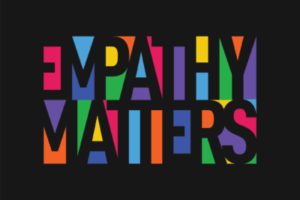The moments you spend sitting next to a patient are precious. As a healthcare provider, the demands on your time make it hard to accomplish everything you’d like to do in the minutes you have to share together.
An effective communication strategy – especially one which includes the effective element of empathy – may help make your time go further toward supporting a positive health outcome.
How effective communication skills support better healthcare
Research shows the difference that effective communication skills can make in healthcare.
“On the positive side, effective communication is a powerful – albeit underutilized – instrument in healthcare’s toolbox. It’s associated with higher patient satisfaction, better adherence to medications, lower likelihood of mistakes, and fewer malpractice cases,” according to an article in Greater Good Magazine from the Greater Good Science Center at the University of California, Berkeley. “It even affects patient health outcomes; a review of research concluded that effective physician-patient communication improves patients’ emotional health, symptoms, physiologic responses, and pain levels.”
However, communicating effectively with patients during interactions that can last merely minutes based on patient load can be a challenge. It involves both listening, understanding and critical thinking from both healthcare provider and patient in order to have an effective two-way exchange of information. This communication can lead to better empathic understanding from healthcare providers.
“In particular, empathy is a critical component of communication that has attracted increasing attention in recent years. Empathy in a clinical context is the physician’s ability to understand patients’ emotions, which can facilitate more accurate diagnoses and more caring treatment,” continues the Greater Good Magazine article. “This differs from sympathy, or sharing patients’ emotions, which instead can hinder objective diagnoses and effective treatment.”
When empathy makes the biggest difference
Years ago, an internal Cleveland Clinic training video on empathy went unexpectedly viral. The video shows patients and providers in a hospital and the thoughts on each person’s mind at the time — highlighting each person’s specific worries, challenges, and joys.

The ability to show empathy in a clinical setting may be especially helpful in serving populations with a reputation as challenging to treat. For example, in an article on the American Academy of Physician Assistants (AAPA) website, Helen Reiss, M.D., director of the Empathy and Relational Science Program at Massachusetts General Hospital, shares a story about why it is difficult for some clinicians to treat patients with eating disorders. She told AAPA that “many clinicians perceived these patients as contributing to their own problem.”
“They didn’t understand that in many cases there were traumatic experiences and many reasons why these patients were not able to ‘Just Eat,’” Riess adds. “What I recognized is that through empathy—through really listening to their stories and creating a safe space for them to talk about things that they’ve never shared before, things that were troubling or shameful or traumatic—there is healing power. It wasn’t just about getting their symptoms under control. [For them], it really was about being understood and feeling as if someone truly cared.”
Knowing the difference that empathy can make in doctor-patient communication, how can you start incorporating more into your practice?
An example of how to sound more empathetic
An article on the Wolters Kluwer website says this is an example of a conversation that lacks empathy for patients:
“You have a virus, and antibiotics don’t cure viruses. We can’t give out antibiotics unless we know it’s a bacterial infection because unneeded antibiotics contribute to resistance and other physical problems. You can take a decongestant and anti-inflammatory, and you should get some extra rest while you wait it out.”

“It sounds like you feel terrible! There are some awful viruses going around, and it looks like you caught one of them. Unfortunately, antibiotics aren’t going to work here. I would give you an antibiotic if I thought it would do anything other than give you a stomachache and diarrhea. Being ill is so frustrating, I know, but I have some ideas that could be helpful and may reduce your symptoms while we wait for the virus to clear.”
The article stresses while neither response is clinically wrong, the first lacks empathy with patients, while the second is a more empathic response, which may “do more to build trust with the patient, even if they’re frustrated.”
Forging deeper connections through communication skills training

Additionally, while electronic medical records often have pre-defined options to help make a healthcare worker’s job easier, the article suggests taking a few extra minutes to “record details that humanize your patient.”
“What’s impacting their life right now? A sick mother? An impending move?” according to the article. “Not only will your patient feel connected when you remember to ask them about this next time, but the more you know about their life, the easier it is to feel empathy.”
Health care providers’ body language in an appointment also plays a role. These nonverbal communication cues can change the impression your patient has of your interaction.
“Just because you are in a rush doesn’t mean you have to act as if you’re in a rush,” says Dr. Helen Riess in Greater Good Magazine. “You can know that you have 15 minutes but still sit down – which makes you much more connected to the person than if you’re standing up – and make good eye contact, nod your head, lean in. All these habits convey that you are present. The worst thing you can do is walk to the door, put your hand on the door handle, and keep talking, because then the person knows that half your mind is already where you’re about to go. Instead, stay seated and say, ‘If you have another brief question, I can answer it now, and if you’d like more time to go over things, let’s schedule another appointment.’ That way, you’re completely with the patient, but you’re not trying to cram ten pounds of flour into a five-pound bag.”
The moments you have to talk to patients might feel short, but you can put each one to good use. Even strong communicators can take advantage of occasional communication skills training and benefit from the value it can provide in working with patients.
For more information, please read these other articles on our website:
https://genesight.com/blog/healthcare-provider/how-minority-cultures-talk-about-depression/
Our articles are for informational purposes only and are reviewed by our Medical Information team, which includes PharmDs, MDs, and PhDs. Do not make any changes to your current medications or dosing without consulting your healthcare provider.
The GeneSight test must be ordered by and used only in consultation with a healthcare provider who can prescribe medications. As with all genetic tests, the GeneSight test results have limitations and do not constitute medical advice. The test results are designed to be just one part of a larger, complete patient assessment, which would include proper diagnosis and consideration of your medical history, other medications you may be taking, your family history, and other factors.
If you are a healthcare provider and interested in learning more about the GeneSight test, please contact us at 855.891.9415. If you are a patient, please talk with your doctor to see if the GeneSight test may be helpful.





